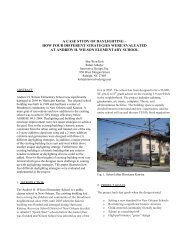SOLAR TODAY - May 2011 - Innovative Design
SOLAR TODAY - May 2011 - Innovative Design
SOLAR TODAY - May 2011 - Innovative Design
Create successful ePaper yourself
Turn your PDF publications into a flip-book with our unique Google optimized e-Paper software.
As a result of the upgrades, the shop floor is well-lit with new Orion Apollo light pipes and lighting<br />
fixtures. Because of supplemental daylighting, each fixture had only two of six lamps lit when this<br />
photo was shot.<br />
electricity to power electric lights. For now, we<br />
took a more direct, less expensive approach.<br />
Last April BAAC hired Beltsville, Md.-based<br />
Hawkins Electric to replace each of the 22 metal<br />
halide, 455-watt fixtures with a corresponding<br />
Orion 192-watt fixture having six T8 fluorescent<br />
lamps. Hawkins also installed a Watt Stopper<br />
open-loop daylight- and occupancy-sensing<br />
system (wattstopper.com). Depending upon<br />
available daylight, the control system<br />
keeps all lights off, or lights two, four<br />
or all six lamps in each fixture. In addition<br />
to daylight controls, occupancy<br />
controls ensure that the lights in each<br />
of the four work sections are switched<br />
off when that section is vacant.<br />
In other interior areas of the building,<br />
Hawkins installed occupancysensing<br />
lighting controls, except where<br />
Copyright © <strong>2011</strong> by the American Solar Energy Society Inc. All rights reserved.<br />
the use of manual controls was effective. For most<br />
rooms, passive infrared sensors worked well, as<br />
there is a straight line of sight between sensor and<br />
occupant. Areas with obstacles (such as a parts<br />
rack) required more expensive ultrasonic sensors.<br />
For corridors, just removing two of three lamps<br />
effectively reduced energy use, while maintaining<br />
adequate lighting.<br />
Upgrades Generate Savings,<br />
Public Kudos<br />
The daylighting and energy-efficiency<br />
upgrade resulted in some significant benefits:<br />
• Greater productivity due to higher lighting levels<br />
and natural light;<br />
• Immediate and automatic lighting response;<br />
• Lower energy bills, as lamps are off when daylighting<br />
is adequate or an area is vacant, BAAC<br />
has more efficient lamps and fixtures, and<br />
unneeded lamps have been removed;<br />
• Less demand on the electric grid, especially<br />
during bright, sunny days, when the grid may<br />
be stressed due to high temperatures and high<br />
air-conditioning loads; and<br />
• Recognition for BAAC’s environmental stewardship.<br />
The chart below illustrates the direct effect<br />
of our conservation efforts. Annual energy use<br />
decreased from 121 megawatt-hours (MWh) average<br />
in 2007 through 2009 to a projected 74 MWh.<br />
That represents a savings of 47 MWh per year,<br />
or $6,980 at 15 cents per kilowatt-hour. Under<br />
the governor’s EmPOWER Maryland initiative<br />
to reduce statewide enerwwgy consumption,<br />
the local utility granted $2,860 for the upgrades,<br />
lowering BAAC’s material and installation costs<br />
from $29,452 to $26,592. As mentioned, these<br />
upgrades will pay off in less than four years.<br />
Because most of the electricity in the mid-<br />
Atlantic region comes from burning coal,<br />
BAAC’s reduced energy demand means less<br />
coal-fired power, reducing emissions of greenhouse<br />
gases and other pollutants. The upgrade<br />
will decrease carbon dioxide emissions by nearly<br />
600 tons during the 20-year life cycle of the<br />
upgrade. (Based on 0.675 tons of carbon dioxide<br />
per megawatt-hour for electricity generation in<br />
Maryland, eia.doe.gov/pub/oiaf/1605/cdrom/<br />
pdf/gg-app-tables.pdf, table C.1.)<br />
“The energy-efficiency efforts of British<br />
American Auto Care are important for the environment<br />
and are reducing their carbon footprint,”<br />
said Orion CEO Neal Verfuerth. “While<br />
the company is doing its part to<br />
help the environment, they received<br />
better light and substantial cost savings,<br />
which make this project a winwin<br />
for everyone.”<br />
Brian England’s commitment to<br />
and actions for the environment led<br />
to BAAC’s selection as one of five<br />
Maryland Green Registry Leadership<br />
Award winners last July. ST<br />
solartoday.org <strong>SOLAR</strong> <strong>TODAY</strong> <strong>May</strong> <strong>2011</strong> 49









